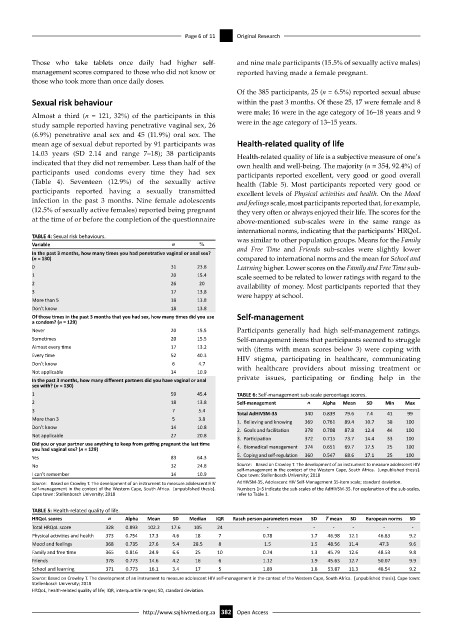Page 390 - HIVMED_v21_i1.indb
P. 390
Page 6 of 11 Original Research
Those who take tablets once daily had higher self- and nine male participants (15.5% of sexually active males)
management scores compared to those who did not know or reported having made a female pregnant.
those who took more than once daily doses.
Of the 385 participants, 25 (n = 6.5%) reported sexual abuse
Sexual risk behaviour within the past 3 months. Of these 25, 17 were female and 8
were male; 16 were in the age category of 16–18 years and 9
Almost a third (n = 121, 32%) of the participants in this
study sample reported having penetrative vaginal sex, 26 were in the age category of 13–15 years.
(6.9%) penetrative anal sex and 45 (11.9%) oral sex. The
mean age of sexual debut reported by 91 participants was Health-related quality of life
14.03 years (SD 2.14 and range 7–18); 38 participants Health-related quality of life is a subjective measure of one’s
indicated that they did not remember. Less than half of the own health and well-being. The majority (n = 354, 92.4%) of
participants used condoms every time they had sex participants reported excellent, very good or good overall
(Table 4). Seventeen (12.9%) of the sexually active health (Table 5). Most participants reported very good or
participants reported having a sexually transmitted excellent levels of Physical activities and health. On the Mood
infection in the past 3 months. Nine female adolescents and feelings scale, most participants reported that, for example,
(12.5% of sexually active females) reported being pregnant they very often or always enjoyed their life. The scores for the
at the time of or before the completion of the questionnaire above-mentioned sub-scales were in the same range as
international norms, indicating that the participants’ HRQoL
TABLE 4: Sexual risk behaviours. was similar to other population groups. Means for the Family
Variable n % and Free Time and Friends sub-scales were slightly lower
In the past 3 months, how many times you had penetrative vaginal or anal sex?
(n = 130) compared to international norms and the mean for School and
0 31 23.8 Learning higher. Lower scores on the Family and Free Time sub-
1 20 15.4 scale seemed to be related to lower ratings with regard to the
2 26 20 availability of money. Most participants reported that they
3 17 13.8 were happy at school.
More than 5 18 13.8
Don’t know 18 13.8
Of those times in the past 3 months that you had sex, how many times did you use Self-management
a condom? (n = 129)
Never 20 15.5 Participants generally had high self-management ratings.
Sometimes 20 15.5 Self-management items that participants seemed to struggle
Almost every time 17 13.2 with (items with mean scores below 3) were coping with
Every time 52 40.3 HIV stigma, participating in healthcare, communicating
Don’t know 6 4.7 with healthcare providers about missing treatment or
Not applicable 14 10.9
In the past 3 months, how many different partners did you have vaginal or anal private issues, participating or finding help in the
sex with? (n = 130)
1 59 45.4 TABLE 6: Self-management sub-scale percentage scores.
2 18 13.8 Self-management n Alpha Mean SD Min Max
3 7 5.4
Total AdHIVSM-35 340 0.839 79.6 7.4 41 99
More than 3 5 3.8 1. Believing and knowing 369 0.761 89.4 10.7 38 100
Don’t know 14 10.8 2. Goals and facilitation 378 0.708 87.8 12.4 44 100
Not applicable 27 20.8 3. Participation 372 0.715 73.7 14.4 33 100
Did you or your partner use anything to keep from getting pregnant the last time
you had vaginal sex? (n = 129) 4. Biomedical management 374 0.651 69.7 17.5 25 100
Yes 83 64.3 5. Coping and self-regulation 360 0.547 68.6 17.1 25 100
No 32 24.8 Source: Based on Crowley T. The development of an instrument to measure adolescent HIV
self-management in the context of the Western Cape, South Africa. [unpublished thesis].
I can’t remember 14 10.9 Cape town: Stellenbosch University; 2018
Source: Based on Crowley T. The development of an instrument to measure adolescent HIV AdHIVSM-35, Adolescent HIV Self-Management 35-item scale; standard deviation.
self-management in the context of the Western Cape, South Africa. [unpublished thesis]. Numbers 1–5 indicate the sub-scales of the AdHIVSM-35. For explanation of the sub-scales,
Cape town: Stellenbosch University; 2018 refer to Table 1.
TABLE 5: Health-related quality of life.
HRQoL scores n Alpha Mean SD Median IQR Rasch person parameters mean SD T mean SD European norms SD
Total HRQoL score 328 0.893 102.2 17.6 105 24 - - - - - -
Physical activities and health 373 0.754 17.3 4.6 18 7 0.78 1.7 46.98 12.1 46.83 9.2
Mood and feelings 368 0.735 27.6 5.4 28.5 8 1.5 1.5 48.56 11.4 47.3 9.6
Family and free time 365 0.816 24.9 6.6 25 10 0.74 1.3 45.79 12.6 48.53 9.8
Friends 378 0.773 14.6 4.2 16 6 1.12 1.9 45.63 12.7 50.07 9.9
School and learning 371 0.773 16.1 3.4 17 5 1.89 1.8 53.87 11.3 48.54 9.2
Source: Based on Crowley T. The development of an instrument to measure adolescent HIV self-management in the context of the Western Cape, South Africa. [unpublished thesis]. Cape town:
Stellenbosch University; 2018
HRQoL, health-related quality of life; IQR, interquartile ranges; SD, standard deviation.
http://www.sajhivmed.org.za 382 Open Access

